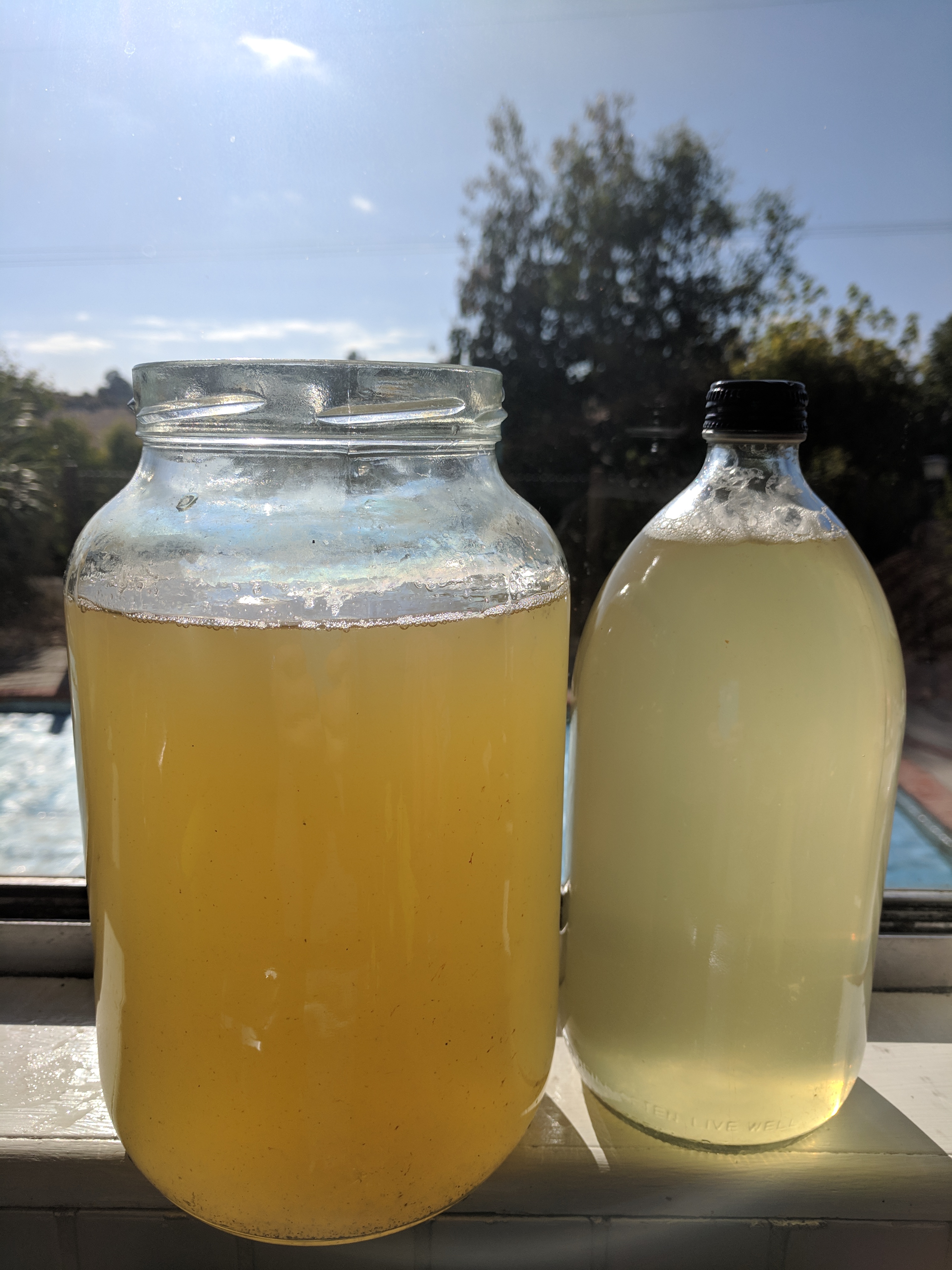I have been making Kombucha for over 4 years and I drink it every day. I first got it about 4 years ago in the health food shop I started working at (still there) to taste and loved it straight away. I wanted to see if my kids would drink it as well and at the time it was a big hit with them. Not as excited now. So I learnt how to make Kombucha and haven’t looked back.
Last year I heard about YUN TEA. It’s called the Champagne of Kombucha and the culture used to ferment is made using green tea and honey. I also heard that it’s not as robust as Kombucha and easier to kill. I was interested but didn’t pursue making it. One of my colleagues at work brought me YUN culture and last week I made my first batch. It took about 6 days to ferment and I must say I love the taste! I can really taste the honey but without it’s intense sweetness and the green tea taste is not detectable at all which is a bit of a surprise to me. In the photo you can see a big jar which is new batch I made this morning and in the glass bottle on the right is the fermented YUN TEA ready to drink. I wonder what my kids will think when they taste it this afternoon.
Here is an article from MindBodyGreen to explore a bit more.
Jun Tea Is The New Kombucha: This Gut-Healing Drink Is About To Be Everywhere
The Jun base is an effective probiotic, and like other fermented foods, it helps replenish your gut of friendly bacteria—a great aid to the digestive system. It’s often referred to as the Champagne of kombuchas due to its delicate taste and high-quality ingredients.
What is Jun Tea?
Unlike regular kombucha, which is fermented with cane sugar and black tea, Jun is made with green tea and relies on a honey sweetener. It’s more mild and less sour than traditional kombucha as a result.
The main difference between Jun and kombucha is that the SCOBY (acronym for symbiotic culture of bacteria and yeast) is trained to feed off of honey rather than sugar from the start. If you put a kombucha culture in a honeyed tea, the bacteria wouldn’t feed properly and would likely die. The Jun culture, however, is designed to use honey as its fuel source.
Feeding the SCOBY with natural honey (instead of the cane sugar used in kombucha) has the added bonus of mineralizing the drink. Jun is also said to build defenses against allergens (thanks to the honey). It also contains a multitude of live enzymes and acids and loads of B vitamins, all essential to a healthy metabolism.
Other than the high-integrity ingredients used in Jun, another advantage is that it ferments at a lower temperatures so it’s much easier to make in the kitchen without having to purchase extra heating equipment typically necessary to make kombucha. Because the honey doesn’t need to be broken down as much as cane sugar, it ferments quickly, a great bonus for those of us who love instant gratification!
Where does Jun tea come from?
The origins of Jun are quite mysterious and surrounded with legend. Some say monks in the Himalayas brewed it for over 1,000 years. The culture was energetically charged by the spiritual environment and thought to be blessed and to be consumed as a spiritual elixir as an aid to enlightenment. However, there is no mention of Jun in Tibetan or Chinese recipe books. Even so, the culture is quite unknown and still relatively hard to find until recent times.
The mythical stories told of Jun’s origins might be a simple function of local farmers’ practices and ecology. In Japan, for example, koji (Aspergillus oryzae) is a culture that starts from rice simply being thrown onto healthy soil. Jun may have risen in the same indirect manner.
There aren’t that many brands available yet, but Moonbrew can be ordered online and comes in flavors like raspberry, sage, and rose and blueberry, mint, lavender, and E3 Live.
How do I make Jun tea?
You can find a SCOBY local to you, or order one online—I got mine off Amazon from Fermentaholics, and it worked great! Here’s the basic process you’ll go through:
- Bring 1.5 liters water to light boil in a kettle.
- Sprinkle loose-leaf Jasmine green tea into a large pitcher.
- Pour hot water over the tea and allow to steep for 2 minutes.
- Strain and place brew in an extra-large glass Mason jar.
- Add in 2 heaping tablespoons honey and stir.
- Allow to cool at room temperature.
- Pour the Jun culture into the jar.
- Allow the tea culture to ferment for 3 days at room temperature.
- After three days, the Jun elixir should smell and taste delicately sweet and sour.
- To use this mother culture again, remove the Jun culture and a ½ cup of the liquid from the top and save for a second batch.
- Allow to ferment a second time for another 2 to 3 days.
- After 2 to 3 days, the Jun tea is ready to drink.
- Place the jar in the refrigerator to chill, or add in spices or juices for different flavors and re-ferment!
https://www.mindbodygreen.com/articles/what-is-jun-tea

